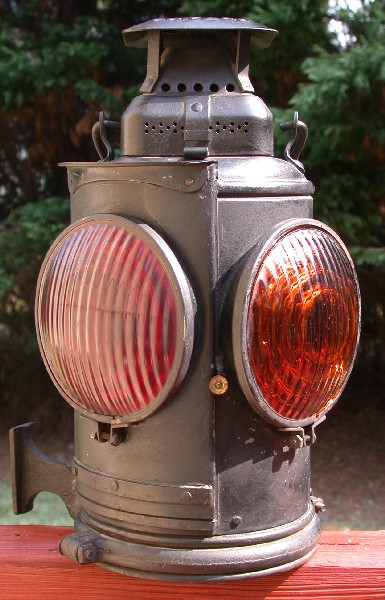

JeffPo's Indiana Harbor Belt Railroad Lamp Page
Last update: 10/28/15


This is a marker lamp (i.e. caboose lamp) made by the Adlake company. It has four 5 3/8" lenses. Three of them are amber/yellow colored.

The fourth lens is red signal color. A marker lamp has a bracket on it to allow it to be fastened to the end car of a train. There was usually one lamp on each side (i.e. two lamps on the back of railcar).
This lamp can be rotated to show either a red light to the
rear, or an amber/yellow light to the rear (the red would be facing the railcar
thus not in use). As the train traveled the tracks, it would keep the red
lens/light facing to the rear, so it functions as a rear of train marker. When
the train would leave the main lines and pull into a siding, they would turn the
lamp to show an amber/yellow signal to the rear. This would let any following
trains know that this train was safely off the main line.

This particular lamp was used by the Indiana Harbor Belt Railroad. It is stamped on the side with the letters: I.H.B. R.R.

Access to the fuel fount was gained by raising the panel with the red lens.

This burner has a glass chimney on it to facilitate the burning of the wick and to help protect the lamp from going out.

In this image you can see the lamp lit, with the red lens facing the camera. It was hard to get the red color to show up in the digital image, like it does naturally to the eye.

In this image you see the lamp lit with one of the amber/yellow lenses facing the camera.

There is also a case where the two marker lamps would actually display different colors from each other at the same time. If there are multiple tracks, and the train is going against the normal current of traffic flow, it would display a red (or amber for some railroads) signal to the rear on the outside of the tracks, and it would display a green signal to the rear on the inside next to the track that is the normal current. Consider the above image with two mainline tracks. Letís assume the track on the right side is the normal current flow of traffic for a train going away from us. The train is on the left track. But the normal traffic flow for the direction the train is traveling is actually on the track on the right. So the marker lamps show red on the left side, which is on the outside of the tracks, and green on the inside, next to the normal current of traffic flow track. If the train had been traveling on the track on the right, which would be the normal flow of traffic, then it would display the typical red signal on both sides of the railcar.

This is the interior of an Indiana Harbor Belt Railroad caboose from 1943. This thing is bigger than some of the rooms in my house!
Indiana Harbor Belt Railroad

The Indiana Harbor Belt Railroad (IHB) was formed in 1907. It was created from such railways as the Chicago Junction Railway and the Chicago, Hammond & Western Railroad. The New York Central had a controlling interest and placed the ownership of the IHB in the hands of the Michigan Central and the Lake Shore & Michigan Southern. The railroad did well in the early part of the 20th century, serving as a connecting railroad, and building hump yards. Its main purpose was a terminal and switching railroad. It abandoned steam early and dieselized, having dropped its last steam engine by 1951. Livestock and ice-cooled perishable shipments were its mainstay. But by 1965, that type of traffic had disappeared. Because of the IHB trackage around Chicago, it provided an efficient connection between Class 1 terminals. Even the run through trains that didn't use the IHB for connecting rail cars paid trackage rights fees, which was a valuable source of income.
Today the Indiana Harbor Belt Railroad still exists as the largest switch carrier in the United States with 54 miles of mainline track (24 miles of which is double main track) and 266 miles of additional yard and siding track. The IHB main line circles Chicago from near O'Hare to Northwest Indiana. The headquarters are in Hammond, Indiana. The IHB operates as an independent road even though it is jointly owned by Norfolk Southern (25.5%), CSX (25.5%) and Canadian Pacific (49%).